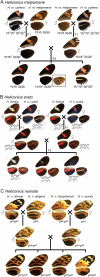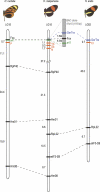A conserved supergene locus controls colour pattern diversity in Heliconius butterflies
- PMID: 17002517
- PMCID: PMC1570757
- DOI: 10.1371/journal.pbio.0040303
A conserved supergene locus controls colour pattern diversity in Heliconius butterflies
Abstract
We studied whether similar developmental genetic mechanisms are involved in both convergent and divergent evolution. Mimetic insects are known for their diversity of patterns as well as their remarkable evolutionary convergence, and they have played an important role in controversies over the respective roles of selection and constraints in adaptive evolution. Here we contrast three butterfly species, all classic examples of Müllerian mimicry. We used a genetic linkage map to show that a locus, Yb, which controls the presence of a yellow band in geographic races of Heliconius melpomene, maps precisely to the same location as the locus Cr, which has very similar phenotypic effects in its co-mimic H. erato. Furthermore, the same genomic location acts as a "supergene", determining multiple sympatric morphs in a third species, H. numata. H. numata is a species with a very different phenotypic appearance, whose many forms mimic different unrelated ithomiine butterflies in the genus Melinaea. Other unlinked colour pattern loci map to a homologous linkage group in the co-mimics H. melpomene and H. erato, but they are not involved in mimetic polymorphism in H. numata. Hence, a single region from the multilocus colour pattern architecture of H. melpomene and H. erato appears to have gained control of the entire wing-pattern variability in H. numata, presumably as a result of selection for mimetic "supergene" polymorphism without intermediates. Although we cannot at this stage confirm the homology of the loci segregating in the three species, our results imply that a conserved yet relatively unconstrained mechanism underlying pattern switching can affect mimicry in radically different ways. We also show that adaptive evolution, both convergent and diversifying, can occur by the repeated involvement of the same genomic regions.
Conflict of interest statement
Competing interests. The authors have declared that no competing interests exist.
Figures




Comment in
-
Repeating patterns of mimicry.PLoS Biol. 2006 Oct;4(10):e341. doi: 10.1371/journal.pbio.0040341. PLoS Biol. 2006. PMID: 17048984 Free PMC article.
-
Jack-of-all-trades "supergene" controls butterfly wing pattern diversity.PLoS Biol. 2006 Oct;4(10):e329. doi: 10.1371/journal.pbio.0040329. Epub 2006 Sep 26. PLoS Biol. 2006. PMID: 20076469 Free PMC article. No abstract available.
References
-
- Carroll SB, Grenier JK, Weatherbee SD. From DNA to diversity: Molecular genetics and the evolution of animal design. Malden (Massachusetts): Blackwell Science; 2001. 214. p.
-
- Gompel N, Prud'homme B, Wittkopp PJ, Kassner VA, Carroll SB. Chance caught on the wing: cis-regulatory evolution and the origin of pigment patterns in Drosophila . Nature. 2005;433:481–487. - PubMed
-
- Müller F. Ituna and Thyridia: A remarkable case of mimicry in butterflies. Trans Entomol Soc Lond 1879. 1879. pp. xx–xxix.
-
- Fisher RA. The genetical theory of natural selection, 2nd revised edition. New York: Dover; 1958. 291. p.
-
- Goldschmidt RB. Mimetic polymorphism, a controversial chapter of Darwinism. Q Rev Biol. 1945;20:147–164. 205–230.
Publication types
MeSH terms
Associated data
- Actions
Grants and funding
LinkOut - more resources
Full Text Sources

